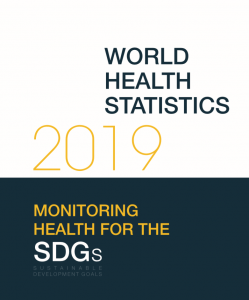
The World Health Statistics series is the World Health Organization’s (WHO’s) annual compilation of health statistics for its 194 Member States. The series is produced by WHO’s Division for Data, Analytics and Delivery, in collaboration with WHO technical departments and regional offices. World health statistics 2019 summarizes recent trends and levels in life expectancy and causes of death (Section 1) and reports on the health and health-related Sustainable Development Goals (SDGs) and associated targets (Sections 2–8). It then summarizes the major findings, including the availability of underlying data for monitoring progress towards the health-related SDGs (Section 9), and concludes by briefly discussing the implications for health policy and the planning of programmes (Section 10). Annex 1 provides regional level statistics, Annex 2 presents country-level statistics for selected health-related SDG indicators and Annex 3 summarizes WHO regional groupings.
The statistics presented in World health statistics 2019 are official WHO statistics based on data available for global monitoring in March 2019. They have been compiled primarily using publications and databases produced and maintained by WHO or by United Nations (UN) groups of which WHO is a member, such as the UN Interagency Group for Child Mortality Estimation. Additionally, a number of statistics have been derived from data produced and maintained by other international organizations, such as the UN Department of Economic and Social Affairs and its Population Division.
The statistics presented are of two types:
- primary data – data compiled by international agencies from routine reporting by countries or publicly available sources such as demographic and health surveys (DHS); statistics are presented as they were reported or with modest adjustment; and
- comparable estimates – country data adjusted or modelled to allow comparisons between countries or over time. Comparable estimates are produced for countries with underlying primary data and, in some cases, also for those without.
In constructing estimates, Member States were asked to review the methodology, data input and the resulting estimates before the estimates were finalized. Comparable estimates are subject to considerable uncertainty, especially for countries where the availability and quality of the underlying primary data are limited. However, to ensure readability, the printed and online versions of the World Health Statistics series do not include the margins of uncertainty, which are instead made available through online WHO databases such as the Global Health Observatory (GHO).
This report also considers the extent to which underlying data are available for use by WHO or other UN agencies or interagency groups. In World health statistics 2019, attention has been given to the availability of data by sex. More details on the indicators and statistics presented here are available from the GHO.